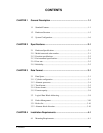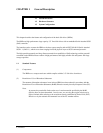
General Description
1-2 C141-E237
(3) SAS Standard
The HDDs are equipped with a serial attached SCSI (SAS) as a host interface.
• Transfer rate: 1.5Gbps, 3.0Gbps
• Number of SAS ports: Two
• Full-duplex (simultaneous bidirectional data transfer) is supported.
SCSI commands can manipulate data through logical block addressing, regardless of the physical
characteristics of the disk drive. This enables software to accommodate expansion of system
functionality.
(4) Dual SAS port support
The HDDs have two pairs of driver and receiver set (PHY) for the SAS to support dual SAS port
connection.
On MAX3147RC, MAX3073RC, and MAX3036RC, Primary and Secondary Ports on SAS plug
connector (2 physical links plus power connections) are used for SAS port connection.
(5) High-speed data transfer
The maximum data-transfer speed on the SAS is 300.0 MB/s. The large-capacity data buffer of the
HDDs enable the effective use of such high-speed data transfers available on the SAS connection.
(6) Continuous block processing
The addressing method of data blocks is logical block address. The initiator (INIT) can access data
by specifying block number in a logically continuous data space without concerning the physical
structure of the track or cylinder boundaries.
The continuous processing up to [64K-1] blocks in a command can be achieved, and the HDDs can
perform continuous read/write operation when processing data blocks on several tracks or cylinder.
(7) Multi-segment data buffer
The data buffer is 16M bytes. Data are transferred between SAS port and disk media through this
data buffer. This feature provides the suitable usage environment for users.
(8) Cache feature
After executing the READ command, the HDDs read automatically and store (prefetches) the
subsequent data blocks into the data buffer (Read-ahead caching).
The high speed sequential data access can be achieved by transferring the data from the data buffer without
reaccessing the disk in case the subsequent command requests the prefetched data blocks.
The Write Cache feature is supported. When this feature is enabled, the status report is issued
without waiting for completion of write processing to disk media, thereby enabling high speed write
processing.


















